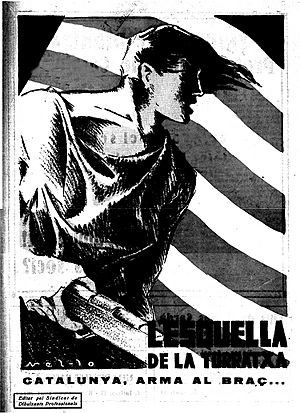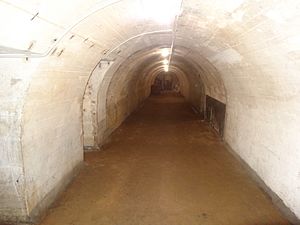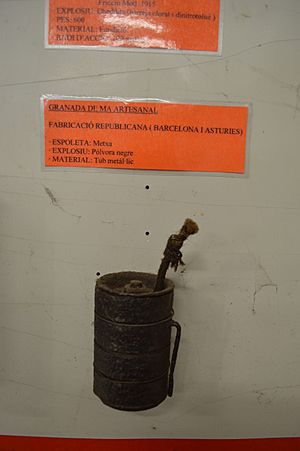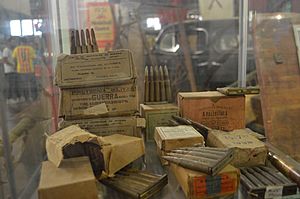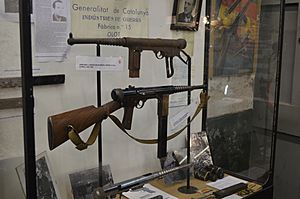War Industries Commission facts for kids
|
Comissió d'Indústries de Guerra
|
|
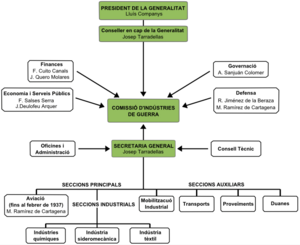
Organizational chart of the War Industries Commission.
|
|
| Abbreviation | CIG |
|---|---|
| Established | August 7, 1936 |
| Dissolved | August 11, 1938 |
|
Membership
|
c. 80,000 |
|
Secretary General
|
Josep Tarradellas |
|
Parent organization
|
Generalitat de Catalunya |
The War Industries Commission (CIG) was a special group created in Catalonia, Spain. It was set up by the Generalitat de Catalunya (the government of Catalonia) on August 7, 1936. Its main goal was to organize and coordinate all factories. They needed to make weapons and supplies for the Republican forces during the Spanish Civil War.
Before the war, Catalonia had almost no factories making war supplies. When the war started, some workshops began making weapons on their own. But this was often not very efficient. So, the CIG was created to make these efforts more effective. It was led by Josep Tarradellas, who was the Minister of Finance.
The CIG stopped people from making weapons at home. It also made rules for factories that changed to making war supplies. They even built new factories for military production. The CIG had two main parts: one for making weapons directly, and another for getting raw materials and machinery from other countries.
The results of the CIG varied. Some factories did very well, while others struggled. It's thought that between 50,000 and 80,000 people worked for the CIG. They worked in about 500 workshops and factories. In 1937, the main Spanish Republican government took over many of these factories. After that, production went down. The CIG stopped working in Catalonia on August 11, 1938.
Contents
How the War Industries Commission Started
The Spanish Civil War began on July 17, 1936. In Catalonia, the uprising against the government was stopped. But Catalonia didn't have many factories that made war materials. Many workers wanted to help. They started making weapons and equipment for soldiers on their own. This quick action was not very efficient. To make these efforts work better, the CIG was created on August 7, 1936. It officially started on August 12.
Who Led the Commission?
The War Industries Commission of Catalonia was led by a Council of War Industries. This council had 8 members. Each member was in charge of different tasks. They were chosen by the Generalitat's government leaders.
Here's how the leadership was set up:
- General Secretary: Josep Tarradellas. He was in charge of the CIG from the beginning to the end.
- Defense: Ricardo Jiménez de la Beraza and Miguel Ramírez de Cartagena Marcaida. Ricardo was an artillery soldier. He helped organize the commission a lot. Miguel was an aviation commander. He led the aviation part of the commission.
- Economy and Public Services: Francesc Salsas Serra and Joan Deulofeu i Arquer. Francesc was a director of a company. Joan was an engineer and had been the mayor of Barcelona.
- Finance: Ferran Cuito Canals and Josep Quero i Molares. Ferran was an engineer and politician. Josep was a lawyer and politician.
- Governance: Alfred San Juan i Colomer. He was a military pilot and a teacher.
Eugenio Vallejo also played a very important role. He was a representative for the Minister of Economy. As a trade unionist (someone who helps workers), he was key to solving problems with the workers.
The CIG's work was split into three main areas: aviation, iron and steel, and chemistry. Miguel Ramírez de Cartagena led aviation. Eugenio Vallejo led iron and steel. Francesc Salsas Serra led chemistry at first.
This council included members from all the political groups in Catalonia. They often had disagreements with the main Spanish Republican government. After the May Days (a period of fighting in Barcelona in May 1937), the council changed. The main government also wanted more control over military production.
Changes and End of the CIG
The Spanish Republican government started to take over some of the CIG's powers. First, they created the Armaments Undersecretariat. This new group took on some of the CIG's responsibilities. In October 1937, the government took control of many factories. These were factories that were run by workers but not owned by the Generalitat. This broke up the strong network the CIG had built.
Sometimes, the Undersecretariat made good decisions. For example, they stopped making armored trucks that weren't very useful in rough terrain. But the way they took over upset the workers. Many workers lost their enthusiasm and didn't produce as quickly as before.
Finally, on August 11, 1938, the remaining 15 CIG factories were fully taken over. They came under the control of the Spanish Armaments and Ammunition Undersecretariat. This happened even though the Generalitat disagreed.
The Factories of the CIG
The CIG organized a large network of about 500 workshops, factories, and labs. These were spread across Catalonia. The CIG took control of companies in different ways. Some were taken over completely, others were managed, and some were just coordinated. This was done with the agreement of the Workers' Control Committee. The CIG mainly focused on metal and chemical industries.
Many factories that used to make things like paper, bicycles, or cosmetics were changed to make cartridges. This was very successful. Many factories produced up to 1 million cartridges per month within a year. The biggest challenges for the CIG were getting enough raw materials and money from other countries.
Some of the large factories in Barcelona that worked with the CIG included:
- Elizalde (400 workers)
- Foret (440 workers)
- Fàbrica Riviere (1,200 workers)
- Maquinista Terrestre i Marítima (1,279 workers)
- Material para Ferrocarriles and Construction (1,500 workers)
- Hispano-Suiza (1,500 workers)
Outside Barcelona, other important factories were:
Many other smaller workshops and factories also worked with the CIG.
The 15 Main CIG Factories
The CIG directly controlled 15 factories. Some were new, and some were taken over. All of them were owned by the Generalitat.
- Factory number 1 (F-1): Made octanol, a special liquid for airplane fuel. It started in July 1936 in Badalona. It produced a good amount of octanol and other chemicals.
- Factory number 2 (F-2): Made natamite, gunpowder, and wicks. Production began in November 1936 in Barcelona. It was hard to start, but production grew quickly. It made large amounts of these materials.
- Factory number 3 (F-3): Mainly made trinitrotoluene (TNT), a powerful explosive. It started in August 1936 in Sant Andreu. It worked closely with F-9. Safety was a concern, and accidents happened.
- Factory number 4 (F-4): Produced cellulose from esparto fiber. This was cheaper than cotton and used to make gunpowder. The CIG took over a paper company in Olot for this purpose.
- Factory number 5 (F-5): Tried to make toxic gases. It was a textile dye factory in Ripollès that was changed. It was the only attempt to work with a factory outside Catalonia. It did not succeed in making toxic gases in large amounts.
- Factory number 6 (F-6): Also aimed to produce toxic substances. It was a new factory in Torelló. It was shut down without making anything.
- Factory number 7 (F-7): Made cartridges and artillery parts like mortars. It was created by the CIG in Sarrià-Sant Gervasi. It was very fast and effective, producing millions of cartridges each month.
- Factory number 8 (F-8): First made lighting rockets and aviation signals. Later, it also made bombs. It started in December 1936 in L'Hospitalet de Llobregat.
- Factory number 9 (F-9): Loaded grenades and worked with F-3. It was in Poblenou. By October 1937, it had loaded over 2 million grenades. The work was complicated and dangerous, causing injuries and some deaths.
- Factory number 10 (F-10): Had two locations. One in Cardona extracted potassium chlorate. The other in Súria Mines extracted bromine. Production was low.
- Factory number 11 (F-11): A large, modern factory making primary explosives, fuses, and projectiles. It was a textile dyeing complex in Santa Coloma de Gramenet that was changed. It made a wide range of materials. Accidents happened due to the dangerous products.
- Factory number 12 (F-12): Its main job was making cartridges. It was in Palau Sacosta. It quickly changed from making bottle caps to producing cartridges.
- Factory number 13 (F-13): A huge complex of 20 buildings being built by the Generalitat. It was meant to produce gunpowder for the entire war. It was so big that it wasn't finished in time. It was located in Gualba.
- Factory number 14 (F-14): First repaired rifles, then started making new ones. It was in Sarrià-Sant Gervasi. Different workshops made parts, which were then sent here to be put together. It made up to 3,000 new Mauser rifles a month.
- Factory number 15 (F-15): A group of workshops in Olot. They focused on making small arms, grenades, and cartridges. They notably produced the Labora Fontbernat M-1938 submachine gun.
Working Conditions

Workers at the CIG generally earned good salaries. However, their workdays were long, and they had few holidays. Sometimes they got one afternoon off a week. They could also work overtime for more pay.
To help workers get food, which was often hard to find, factories offered benefits. Some factories made sure workers received bread or milk. This helped prevent production from stopping. In chemical factories, workers often faced dangers because safety measures were not always perfect. Handling explosives sometimes led to injuries or even deaths.
For male workers, one big reason to work in these factories was to avoid being sent to the war front. However, the rules for this were not always clear. Young workers sometimes ended up joining the army anyway. This was another point of disagreement between the main Republican government and the CIG.
Materials Produced
Here's a list of war materials produced by the CIG factories until September 30, 1937:
Grenades
- 70mm, 75mm, 105mm, 155mm breaking grenades: Over 600,000 units
- 105mm, 155mm shrapnel grenades: About 9,000 units
- 50mm, 81mm mortar grenades: Over 90,000 units
To make these, almost 10,000 tons of iron were used.

Aviation Bombs
- Various aviation bombs: Over 52,000 units
About 2,500 tons of cast iron were needed for these.
Fuses
- Special fuses: Over 96,000 units
- Other fuses: Over 469,000 units
In total, over 566,000 fuses were made using about 1,200 tons of brass.
Bullets
- Mauser rifle bullets: Over 71 million units
This took 500 tons of lead and 400 tons of brass.
- 9mm long pistol cases and bullets: Over 600,000 units
Masks
- Gas masks: 100,000 units
- Civilian gas masks (being made): 100,000 units
These masks came with filters.
Transports
- Transport trucks: 385
- Ambulance trucks: 284
- Armored trucks: 147
- Water tanker trucks: 142
- Gasoline tank trucks: 30
- Caterpillar trucks for cannon trailer: 22
- Other special trucks (workshop, kitchen, crane): 105
A total of 1,115 vehicles were produced.
Other Supplies
- Barbed wire: Over 18 million meters
- Stakes for barbed wire: Over 419,000 units
- Pickaxes: Over 53,000 units
- Shovels: Over 46,000 units
- Handles for picks: Over 38,000 units
- Thorns for barbed wire: Over 8,000 packages
Many other tools like clubs, axes, and hoes were also made.
New Ideas and Inventions
The CIG also looked into new weapon ideas. These ideas often came from individuals or local groups. They ranged from building armored vehicles to creating war rockets and even remote-controlled devices. Some of these projects moved forward, while others did not.
Armored Vehicles
At the start of the war, people wanted to make tanks. But they only managed to make armored cars with machine guns. These armored trucks, sometimes called tiznaos, were not very good off-road. They also broke down often because of the extra weight. The only real tanks in the war came from other countries. The CIG hoped to make its own tank.
A workshop in Sant Sadurní d'Anoia called Factory Z had experience making construction machinery. They had made caterpillar tractors before the war. These tractors, used for moving snow and earth, became the basis for the Sadurní armored vehicles. These were modern armored vehicles. They used Hispano Suiza engines and had caterpillar tracks.
During the war, Factory Z started making armored artillery tractors. They also made semi-caterpillars for pulling aircraft. They even repaired Soviet tanks. In early 1937, they started building their own tank prototype. It had a 7mm Hotchkiss machine gun and was covered in steel. Factory Z also made armored personnel carriers using the same base. These could carry about 6 men but had an open roof.
These armored vehicles, known as the Sadurní tank, were quite modern. However, there wasn't enough steel or other materials. Production was slow, and there was no easy way to repair them. So, the Republican government decided not to make them in large numbers. It's not known if these prototypes were used in battle.
Rockets
During the Spanish Civil War, rockets were mostly used for sending messages to the enemy. They also lit up battlefields at night or sent signals. A few projects tried to use rockets for fighting.
One project was by Josep Belmonte Cañellas. He designed a simple rocket launcher called Torpede aeri (Air Torpedo). This rocket was 70cm long and had an explosive charge. It could fly very fast and had a range of 1,000-4,000 meters. Belmonte also suggested other uses for the rocket. The CIG considered making 6 models to test them, but the idea didn't go forward.
Another rocket project was by Ramon Angelats. He knew that artillery shells were very expensive. He designed a rocket that could fly 3,000-4,000 meters with a 4kg explosive. 24 of these rockets were used in battle. Even though they were made in Catalonia, the CIG was not involved in this project.
Unmanned Devices
There are old photos of what look like unmanned naval devices. These are kept in the Montserrat Tarradellas i Macià Archive. One looks like a small boat with a radio control system. The photos show parts like transmitters, receivers, and motors. This suggests it might have been a guidance system for the device.
Another unmanned naval device looks like a target for shooting practice. It was small and uniquely shaped. It could have been used for testing weapons or to trick the enemy.
Technical Publications
To record their production methods and successes, the CIG published a series of technical publications. There were seventeen volumes in total, but up to twenty-eight different titles.
| Book Title | Volumes | Book Title | Volumes |
|---|---|---|---|
| 70mm breaking grenades | I | 70kg aviation pumps | XIV |
| 75mm breaking grenades | II | 250kg aviation pumps | XV |
| 105mm grenade launchers | III | 500kg aviation pumps | XVI |
| 155mm breaking grenades | IV | Fuses for aviation bombs | XVII |
| 105mm shrapnel grenades | V | Hand pumps | XVIII |
| 155mm shrapnel grenades | VI | Grenades L.G.1 | XIX |
| 50mm mortar grenades | VII | Grenade launcher L.G.1. | XX |
| 81mm mortar grenades | VIII | 50mm mortar | XXI |
| 45mm steel grenades, high explosive | IX | 81mm mortar | XII |
| 7.65cm anti-aircraft grenades | X | Ascaso Pistol | XXIII |
| Fuses | XI | Fontbernat machine gun | XXIV |
| Cartridges | XII | Carabiner Mauser | XXV-XXVI-XXVII |
| 12kg aviation pumps | XIII | Smokeless powders | XXVIII |
See also
 In Spanish: Industria de guerra en Cataluña para niños
In Spanish: Industria de guerra en Cataluña para niños
- Catalonia Offensive
- Polikarpov I-15


